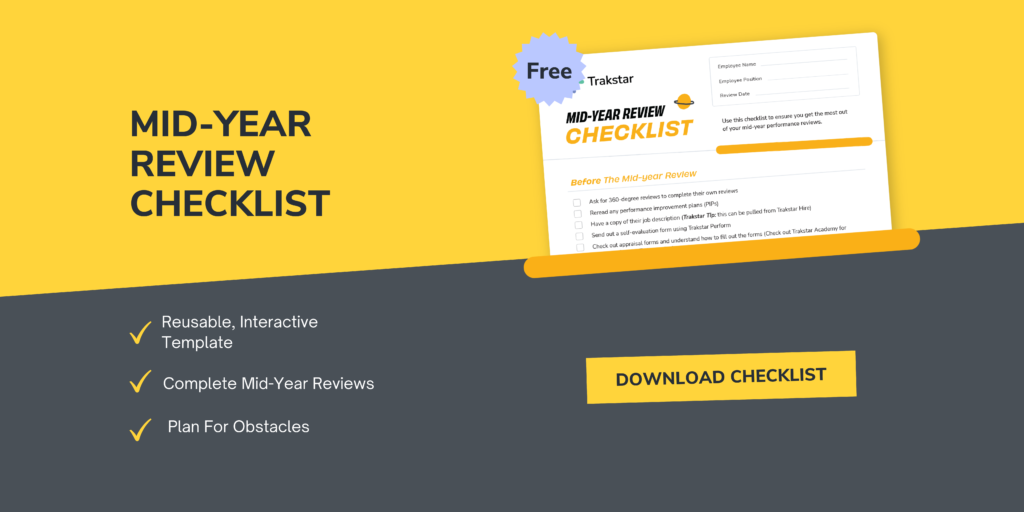Definitive Guide To Mid-Year Performance Reviews
Posted by Trakstar • June 17, 2022 (Last modified June 29, 2022) • 7 min read
How are your mid-year performance reviews going? You can be honest – this is a stressful time for many people (HR leaders and employees alike), and sometimes things don’t go smoothly.
Mid-year performance reviews are the pre-set time when managers sit down with their employees to talk about how the first half of the year went and what can be done to improve (or continue) in the year’s second half. This is similar to an annual review, but most companies won’t be as formal. It’s more of a check-in or a course correct than a full-on review.
The importance of a mid-year performance review is that employees have a chance to feel heard and seen, especially when the workforce has shifts, is remote, or managers don’t work directly with their employees every day. Employees can approach mid-year reviews with anxiety, dread, and sometimes even confusion. Particularly right now, thoughts can bring up some of the worst fears for workers. Many performance review examples don’t consider the current world, the rise of remote and hybrid work, or the fact that people’s lives have changed dramatically.
We need to revolutionize how we look at mid-year performance reviews and possibly change how we do it. Want some quick best practices for mid-year assessments? Click here to download Trakstar Academy’s guide.
For a complete guide, keep reading.
Benefits of Mid-Year Performance Reviews
What is the importance of mid-year performance reviews? To complete a successful mid-year performance review, you need to know your why. Many employers don’t use mid-year appraisals, so why should you? The answer isn’t going to be the same for everyone, but you need to think about your answer before successfully executing a mid-year performance review.
According to SHRM, “Fundamentally, checking in frequently with direct reports assists in building relationships and a cohesive team. A formal six-month performance appraisal allows for midyear adjustments, preventing surprises at the year-end performance review.”
If you aren’t sold on the idea of a mid-year performance review, here are a few other reasons why you should consider them:
- Ensure your employees are happy – reduce churn and improve company culture
- Keep everyone on the same page
- Course correct any bad habits that may have formed throughout the year
- Communicate goals, expectations, objectives, and roles
- Discuss any potential problems that could be bubbling up
- Plan succession, role changes, promotions, etc.
- Foster a positive relationship and dynamic between managers and employees
- Eliminate roadblocks to future success
- Take corrective action
- Review and analyze job descriptions, roles, and specific goals
There are so many reasons why mid-year performance management is essential. However, HR leaders can’t just focus on getting them done and over with – they need to be valuable.
Mid-Year Performance Review Timeline
When you complete performance reviews, it is essential not to phone things in or give everyone the same experience. However, there are little things you can do to automate and streamline the performance review process so that you can spend more time making plans, going over notes, and doing the work that matters. It’s not about automating your entire performance review process; it’s about automating what doesn’t matter for talent development.
One of the best ways to make the most significant impact on your workforce with mid-year performance reviews is to use performance management software – to learn more about the best-in-breed performance management software that makes annual, quarterly, mid-year, and 360-degree reviews much more accessible, schedule a demo of Trakstar today.
Think About The Type of Review You Want
The first thing you want to do is think about the type of review that you want to hold. Do you want to do a formal review where someone self-reviews? Something a little more casual where you meet to go over things? Do you want to gather 360-degree reviews from coworkers and other departments?
Once you’ve determined what kind of review you want, you can move on to the rest of the steps. The further out from the review you can determine this, the better it will be.
Schedule Your Mid-Year Performance Review
Mid-year reviews aren’t going to be as formalized, but there are certain things you need to do early to prepare. The most important thing you can do is set aside time in your employee’s schedule to have a mid-year review. Ensure that you give both of you the chance to get notes aligned, look over performance metrics, and generally have a plan for what to talk about.
Actually Do The Prep Work
Once you’ve scheduled a meeting to do the performance review and the prep-work, you have to do it. Collect all the information you need about your employees to complete your review. Analyze their performance individually and at the team, department, and company levels. Think about how they fit into departmental goals, what they’ve done to help you reach them, and what they can do in the future.
You should review old reviews or performance improvement plans you made in previous studies. Look at any notes you’ve made, check over reports, and start creating a list of topics and questions to ask your employee.
During this time, try to identify areas of improvement and places where they have improved or exceeded expectations.
Write Down Your Meeting Plan
Before your mid-year review, you want to structure it a little bit. A word of caution, you don’t want your review to feel rehearsed, but you don’t want it to go off the rails either. It’s best to lay out some kind of game plan before a review, particularly one that might be hard.
Know that your employee will have some anxiety around the review, so sending them a brief outline of the evaluation can help alleviate some of that stress. It can also help them prepare for the meeting.
Follow Through
Once the day comes, you should be prepared to handle it. Now, all you have to do is execute it. If this is your first time giving performance reviews, it might be a good idea to wear light clothing, find a comfortable location, and take a few deep breaths.
You can handle your mid-year reviews however you’d like, or you can follow this mid-year performance review template and timeline:
- Start by asking your employee if they understand why mid-year reviews are important.
- Ask them how they feel their performance is going, including any achievements or progress. You might be surprised at what you hear!
- Comment on things that your employee has done well. Start by highlighting your favorite achievements (bonus points if they are different from what they said!)
- Broach the topic of challenges and complications by first listening to your employee. See if they bring up areas that you have concerns about as well.
- Talk about areas where your employee can improve – and then tell them how you will help them. This is a great time to discuss courses in your learning management system.
- If necessary, broach the topic of a performance improvement plan (PIP) to help them reach goals.
- Ask your employee about their future goals and formulate a plan to help them get there.
- Summarize the conversation and ask your employee if they have anything else they’d like to add.
- Thank your employee for their time.
When you finish your review, it is a great idea to put notes in Trakstar Perform. Then, you should send your employee a copy of the review to have them sign off on it.
Make Mid-Year Reviews Easier
For managers struggling with mid-year reviews, whether this is your first time or fiftieth time, it’s essential to know that you are doing it for the betterment of your employees, your company, and even yourself. Mid-year reviews can help save time, effort, and money in the long run.
Mid-year reviews will feel different from annual reviews, so you want to differentiate them. However, you don’t want this to feel like something that doesn’t have meaning. If you think that way, so will your employees.
Want to make reviews easier and more effective – no matter what time of the year you have them? Schedule a demo of the Trakstar platform today.
Don't Miss Out on More Great HR Articles!
Subscribe to get the latest, greatest HR and Talent Development content straight to your inbox.



